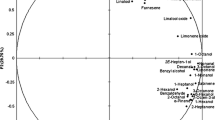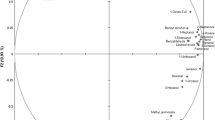Abstract
The boll weevil, Anthonomus grandis, has been monitored through deployment of traps baited with aggregation pheromone components. However, field studies have shown that the number of insects caught in these traps is significantly reduced during cotton squaring, suggesting that volatiles produced by plants at this phenological stage may be involved in attraction. Here, we evaluated the chemical profile of volatile organic compounds (VOCs) emitted by undamaged or damaged cotton plants at different phenological stages, under different infestation conditions, and determined the attractiveness of these VOCs to adults of A. grandis. In addition, we investigated whether or not VOCs released by cotton plants enhanced the attractiveness of the aggregation pheromone emitted by male boll weevils. Behavioral responses of A. grandis to VOCs from conspecific-damaged, heterospecific-damaged (Spodoptera frugiperda and Euschistus heros) and undamaged cotton plants, at different phenological stages, were assessed in Y-tube olfactometers. The results showed that volatiles emitted from reproductive cotton plants damaged by conspecifics were attractive to adults boll weevils, whereas volatiles induced by heterospecific herbivores were not as attractive. Additionally, addition of boll weevil-induced volatiles from reproductive cotton plants to aggregation pheromone gave increased attraction, relative to the pheromone alone. The VOC profiles of undamaged and mechanically damaged cotton plants, in both phenological stages, were not different. Chemical analysis showed that cotton plants produced qualitatively similar volatile profiles regardless of damage type, but the quantities produced differed according to the plant’s phenological stage and the herbivore species. Notably, vegetative cotton plants released higher amounts of VOCs compared to reproductive plants. At both stages, the highest rate of VOC release was observed in A. grandis-damaged plants. Results show that A. grandis uses conspecific herbivore-induced volatiles in host location, and that homoterpene compounds, such as (E)-4,8-dimethylnona-1,3,7–triene and (E,E)-4,8,12-trimethyltrideca-1,3,7,11-tetraene and the monoterpene (E)-ocimene, may be involved in preference for host plants at the reproductive stage.





Similar content being viewed by others
References
Addesso, K. M. and McAuslane, H. J. 2009. Pepper weevil attraction to volatiles from host and nonhost plants. Environ. Entomol. 38:216–224.
Addesso, K. M., McAuslane, H. J., and Alborn, H. T. 2011. Attraction of pepper weevil to volatiles from damaged pepper plants. Entomol. Exp. App. 138:1–11.
Beltrão, N. E. M. and Azevedo, D. M. P. 2008. pp. 12–17, O agronegócio do algodão no Brasil. Embrapa Informação Tecnológica, Brasília.
Bernasconi, M. L., Turlings, T. C. J., Ambrosetti, L., Bassetti, P., and Dorn, S. 1998. Herbivore-induced emissions of maize volatiles repel the corn leaf aphid, Rhopalosiphum maidis. Entomol Exp. App. 87:133–142.
Bichão, H., Borg-Karlson, A. K., Araújo, J., and Mustaparta, H. 2005. Five types of olfactory receptor neurons in the strawberry blossom weevil Anthonomus rubi: selective responses to inducible host plants volatiles. Chem. Senses 30:153–170.
Bolter, C. J., Dicke, M., Van-Loon, J. J. A., Visser, J. H., and Posthumus, M. A. 1997. Attraction of Colorado potato beetle to herbivore-damaged plants during herbivory and after its termination. J. Chem. Ecol. 23:1003–1023.
Borges, M., Laumann, R. A., Silva, C. A. S., Moraes, M. C. B., Santos, H. M., and Tibúrcio, D. T. 2006. pp. 18, Metodologias de criação e manejo de colônias de percevejos da soja (Hemiptera-Pentatomidae) para estudos de comportamento e ecologia química. Documento No 182. Editora Embrapa, Brasília, Brasil.
Borges, M., Millar, J. G., Laumann, R. A., and Moraes, M. C. B. 2007. A male-produced sex pheromone from the neotropical redbanded stink bug, Piezodorus guildinii (W.). J. Chem. Ecol. 33:1235–1248.
Bruce, T. J. A., Midega, C. A. O., Birkett, M. A., Pickett, J. A., and Khan, Z. R. 2010. Is quality more important than quantity? Insect behavioural responses to changes in a volatile blend after stemborer oviposition on an African grass. Biol. Lett. 6:314–317.
Dickens, J. C. 1984. Olfaction in the boll weevil, Anthonomus grandis Boh. (Coleoptera: Curculionidae): eletroantennogram studies. J. Chem. Ecol. 10:1759–1785.
Dickens, J. C. 1985. Orientation of boll weevil, Anthonomus grandis Boh. (Coleoptera: Curculionidae), to pheromone and volatile host compound in the laboratory. J. Chem. Ecol. 12:91–98.
Dickens, J. C. 1989. Green leaf volatiles enhance aggregation pheromone of boll weevil, Anthonomus grandis. Entomol. Exp. App. 52:191–203.
Dickens, J. C., Jang, E. B., Light, D. M., and Alford, A. R. 1990. Enhancement of insect pheromone responses by green leaf volatiles. Naturwissenschaften 77:29–31.
Hare, J. D. 2011. Ecological role of volatiles produced by plants in response to damage by herbivorous insects. Annu. Rev. Entomol. 56:161–180.
Hegde, M., Oliveira, J. N., Costa, J. G., Bleicher, E., Santana, A. E. G., Bruce, T. J. A., Caulfield, J., Dewhirst, S. Y., Woodcock, C. M., Pickett, J. A., and Birkett, M. A. 2011. Identification of semiochemical released by cotton, Gossypium hirsutum, upon infestation by the cotton aphid, Aphis gossypii. J. Chem. Ecol. 37:741–750.
Kalberer, N. M., Turlings, T. C. J., and Rahier, M. 2001. Attraction of leaf beetle (Oreina cacaliae) to damaged host plants. J. Chem. Ecol. 27:647–661.
Kalinova, B., Stransky, K., Harmatha, J., Ctvrtecka, R., and Zd’arek, J. 2000. Can chemical cues from blossom buds influence cultivar preference in the apple blossom weevil (Anthonomus pomorum)? Entomol. Exp. Appl. 95:47–52.
Leopold, E. J. 1990. Selective hydroboration of a 1, 3, 7-triene: homogeraniol. Org. Synth. 64:164–171.
Loughrin, J. H., Manukian, A., Heath, R. R., and Tumlinson, J. H. 1995. Volatiles emitted by different cotton varieties damaged by feeding beet armyworm larvae. J. Chem. Ecol. 21:1217–1222.
Loughrin, J. H., Potter, D. A., Hamilton-Kemp, T. R., and Byers, M. E. 1996. Role of feeding-induced plant volatiles in aggregative behavior of the Japanese beetle (Coleoptera: Scarabaeidae). Environ. Entomol. 25:1188–1191.
McCall, P. J., Turlings, T. C. J., Loughrin, J., Proveaux, A. T., and Tumlinson, J. H. 1994. Herbivore-induced volatile emissions from cotton (Gossypium hirsutum L.) seedlings. J. Chem. Ecol. 20:3039–3049.
McKibben, G. H., Mitchell, E. B., Scott, W. P., and Hedin, P. A. 1977. Boll weevils are attracted to volatile oils from cotton plants. Environ. Entomol. 6:804–806.
Meiners, T., Hacker, N. K., Anderson, P., and Hilker, M. 2005. Response of the elm leaf beetle to host plants induced by oviposition and feeding: the infestation rate matters. Entomol. Exp. Appl. 115:171–177.
Michereff, M. F. F., Laumann, R. A., Borges, M., Michereff Filho, M., Diniz, I. R., Farias-Neto, A. L., and Moraes, M. C. B. 2011. Volatiles mediating plant-herbivory-natural enemy interaction in resistant and susceptible soybean cultivars. J. Chem. Ecol. 37:273–285.
Moraes, M. C. B., Laumann, R. A., Sujii, E. R., Pires, C. S. S., Borges, M., and Millar, J. G. 2005. Sex attractant pheromone from the neotropical red-shouldered stink bug, Thyanta perditor (F.). J. Chem. Ecol. 31:1415–1427.
Moraes, M. C. B., Laumann, R. A., Pareja, M., Sereno, F. T. P. S., Michereff, M. F. F., Birkett, M. A., Pickett, J. A., and Borges, M. 2009. Attraction of the stink bug egg parasitoid Telenomus podisi to defence signals from soybean activated by treatment with cis-jasmone. Entomol. Exp. Appl. 131:178–188.
Moraes, M. C. B., Laumann, R. A., Aquino, M. F. S., Paula, D. P., and Borges, M. 2011. Effect of Bt genetic engineering on indirect defense in cotton via a tritrophic interaction. Transgenic Res. 20:99–107.
Nist. 2011. Software NIST/EPA/NIH Mass Spectral Library 2011.
Nist. 2008. Software NIST/EPA/NIH Mass Spectral Library 2008.
Nunes, J. C. S. and Fernandes, P. M. 2000. Parasitismo do bicudo do algodoeiro (Anthonomus grandis) em botões florais do algodoeiro, no município de Goiânia-GO. Pesqui. Agropecu. Trop. 30:13–15.
Paré, P. W. and Tumlinson, J. H. 1998. Cotton volatiles synthesized and released distal to the site of insect damage. Phytochemistry 47:521–526.
Paré, P. W. and Tumlinson, J. H. 1996. Volatile signals in response to herbivore feeding. Fla. Entomol. 79:93–103.
Pherobase. 2011. Database of pheromone and other semiochemicals. <http://www.pherobase.com/database/kovats/kovats-index.php>.
R Development Core Team. 2009. A language and environment for statistical computing. R Foundation for Statistical Computing, Vienna, Austria.
Ribeiro, P. A., Sujii, E. R., Diniz, I. R., Medeiros, M. A., Salgado-Labouriau, M. L., Branco, M. C., Pires, C. S. S., and Fontes, E. M. G. 2010. Alternative food sources and overwintering feeding behavior of the boll weevil, Anthonomus grandis Boehman (Coleoptera: Curculionidae) under the tropical conditions of Central Brazil. Neotropical Entomol. 39:28–34.
Rochat, D., Meillour, P. N., Esteban-Duran, J. R., Malosse, C., Perthuis, B., Morin, J. P., and Descoins, C. 2000. Identification of pheromone synergists in the American palm weevil, Rhynchophorus palmarum, and attraction of related Dynamis borassi. J. Chem. Ecol. 26:155–187.
Rodriguez-Saona, C., Crafts-Brandner, S. J., and Cañas, L. A. 2003. Volatile emissions triggered by multiple herbivore damage: beet armyworm and whitefly feeding on cotton plants. J. Chem. Ecol. 29:2539–2550.
Röse, U. R. S., Manukian, A., Heath, R. R., and Tumlinson, J. H. 1996. Volatile semiochemicals released from undamaged cotton leaves (a systemic response of living plants to caterpillar damage). Plant Physiol. 111:487–495.
Röse, U. R. S., Lewis, W. J., and Tumlinson, J. H. 1998. Specificity of systemically released cotton volatiles as attractants for specialist and generalist parasitoid wasps. J. Chem. Ecol. 24:303–319.
Rummel, D. R. and Curry, G. L. 1986. Dinâmica populacional e níveis de dano econômico, pp. 201–220, in S. Barbosa, M. J. Lukefarh, and R. B. Sobrinho (eds.), O Bicudo do Algodoeiro, Vol. 4. Departamento de Difusão Tecnológica Documentos, Embrapa.
Schmidt, F. G. V., Monnerat, R. G., Borges, M., and Carvalho, R. S. 2001. pp. 20, Metodologia de Criação de Insetos para Avaliação de Agentes Entomapatogênicos. Circular Técnica No 11. Ed. Embrapa, Brasília, Brasil.
Showler, A. T. 2004. Influence of cotton fruit stages as food sources on boll weevil (Coleoptera:Curculionidae) fecundity and oviposition. J. Econ. Entomol. 97:1330–1334.
Stamps, J. and Krishnan, V. V. 2005. Nonintuitive cue use in habitat selection. Ecology 86:2860–2867.
\Szendrei, Z., Malo, E., Stelinski, L., and Rodriguez-Saona, C. 2009. Response of cranberry weevil (Coleoptera: Curculionidae) to host plant volatiles. Entomol. Soc. Am. 38:861–869.
Tumlinson, J. H., Hardee, D. D., Gueldner, R. C., Thompson, A. C., Hedin, P. A., and Minyard, J. P. 1969. Sex pheromone produced by the male boll weevil: isolation, identification, and synthesis. Science 166:1010–1012.
Turlings, T. C. J., Tumlinson, J. H., and Lewis, W. J. 1993. An elicitor in caterpillar oral secretion that induces corn seedlings to emit chemical signals attractive to parasitic wasps. J. Chem. Ecol. 19:411–425.
Turlings, T. C. J., Bernasconi, M., Bertossa, R., Bigler, F., Caloz, G., and Dorn, S. 1998. The induction of volatile emissions in maize by three herbivore species with different feeding habits: possible consequences for their natural enemies. Biol. Control. 11:122–129.
White, J. R. and Rummel, D. 1978. Re-emergence profile of over-wintered boll weevils an entry into cotton. Environ. Entomol. 7:7–14.
Yang, Z., Bengtsson, M., and Witzgall, P. 2004. Host plant volatiles synergize response to sex pheromone in codling moth, Cydia pomonella. J. Chem. Ecol. 30:619–629.
Acknowledgments
We thank Isabella Grisi for helping with laboratory rearing of the insects. We also thank the Post-Graduate Ecology Program of the University of Brasília (UnB) for use of their facility. This work received financial support from the Coordination of Superior Level Staff Improving’s (CAPES) through a grant to Diego M Magalhães, and from the International Foundation for Science (IFS), Federal District Research Foundation (FAP-DF) and the Brazilian Corporation of Agricultural Research (EMBRAPA).
Author information
Authors and Affiliations
Corresponding author
Rights and permissions
About this article
Cite this article
Magalhães, D.M., Borges, M., Laumann, R.A. et al. Semiochemicals from Herbivory Induced Cotton Plants Enhance the Foraging Behavior of the Cotton Boll Weevil, Anthonomus grandis . J Chem Ecol 38, 1528–1538 (2012). https://doi.org/10.1007/s10886-012-0216-5
Received:
Revised:
Accepted:
Published:
Issue Date:
DOI: https://doi.org/10.1007/s10886-012-0216-5




